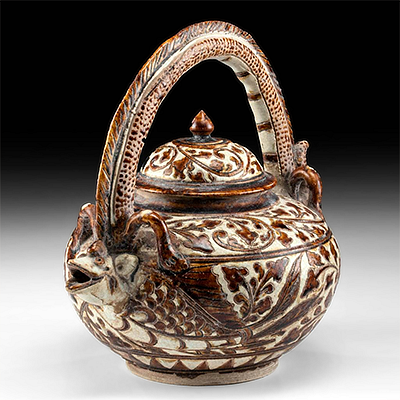19th C. Chinese Wood Acupuncture Teaching Model
Lot 59b
About Seller
Artemis Gallery
686 S Taylor Ave, Ste 106
Louisville, CO 80027
United States
Selling antiquities, ancient and ethnographic art online since 1993, Artemis Gallery specializes in Classical Antiquities (Egyptian, Greek, Roman, Near Eastern), Asian, Pre-Columbian, African / Tribal / Oceanographic art. Our extensive inventory includes pottery, stone, metal, wood, glass and textil...Read more
Categories
Estimate:
$3,600 - $5,400
Absentee vs Live bid
Two ways to bid:
- Leave a max absentee bid and the platform will bid on your behalf up to your maximum bid during the live auction.
- Bid live during the auction and your bids will be submitted real-time to the auctioneer.
Bid Increments
| Price | Bid Increment |
|---|---|
| $0 | $25 |
| $300 | $50 |
| $1,000 | $100 |
| $2,000 | $250 |
| $5,000 | $500 |
| $10,000 | $1,000 |
| $20,000 | $2,500 |
| $50,000 | $5,000 |
| $100,000 | $10,000 |
| $200,000 | $20,000 |
About Auction
By Artemis Gallery
Jul 1, 2021
Set Reminder
2021-07-01 10:00:00
2021-07-01 10:00:00
America/New_York
Bidsquare
Bidsquare : Antiquities | Asian | Ethnographic Art
https://www.bidsquare.com/auctions/artemis-gallery/antiquities-asian-ethnographic-art-7148
Featuring classical antiquities, ancient and ethnographic art from cultures encompassing the globe. Egyptian, Greek, Roman, Near Eastern, Asian, Pre-Columbian, Native American, African / Tribal, Oceanic, Spanish Colonial, Russian, Fossils, Fine Art, more! All legally acquired, legal to sell. Artemis Gallery info@artemisgallery.com
Featuring classical antiquities, ancient and ethnographic art from cultures encompassing the globe. Egyptian, Greek, Roman, Near Eastern, Asian, Pre-Columbian, Native American, African / Tribal, Oceanic, Spanish Colonial, Russian, Fossils, Fine Art, more! All legally acquired, legal to sell. Artemis Gallery info@artemisgallery.com
- Lot Description
East Asia, China, ca. 1860 to 1880 CE. A sizeable, carved wooden male model with black-painted inscriptions used to teach acupuncture in China. The standing figure is marked with various acupuncture holes representing pressure points where needles should be placed on the human body as well as the meridians through which the qi (chi) or energy in the body flows. It is necessary for qi to flow freely along the body's channels or meridians in order to ensure good health. Acupuncture was developed in China and spread throughout East Asia, especially Korea and Japan, centuries before Europeans learned of the practice. Dutch physician Willem ten Rhijne, who studied acupuncture in Japan for two years, wrote "De Acupunctura," the first European text on the subject published in 1683. It was not until 1823 that British surgeon James Morss Churchill wrote "A Treatise on Acupuncturation," the first English text on acupuncture. Size: 5.7" L x 8.375" W x 31.375" H (14.5 cm x 21.3 cm x 79.7 cm); 32.5" H (82.6 cm) on included custom stand.
According ot the Wood Library Museum of Anesthesiology, "The practice of acupuncture is based on the ancient Chinese concept of yin yang balance. Yin and yang represent the interdependent opposites that exist in everything, and for good health the two must be in balance. According to traditional Chinese Medicine, a metaphysical energy called "qi", or “chi”, is believed to circulate throughout the body along invisible channels called meridians. It is thought that stagnation or problems with the flow of "qi" causes a yin yang imbalance. To restore that balance, the skin is punctured with very fine needles at acupoints. Most acupoints are found along the body’s twelve meridians. Practitioners of acupuncture use it to relieve pain and to treat a variety of health conditions."
Provenance: private Hawaii, USA collection; ex Lissauer collection, Sydney, Australia, 1950 to 2000
All items legal to buy/sell under U.S. Statute covering cultural patrimony Code 2600, CHAPTER 14, and are guaranteed to be as described or your money back.
A Certificate of Authenticity will accompany all winning bids.
We ship worldwide and handle all shipping in-house for your convenience.
#161503Body shows age crack down center from chest to waist wrap. Integral cylindrical base shows expected wear with abrasions, surface losses, and age cracks, the largest to right and below left proper foot as shown. Arms either carved separately and joined to body or reattached. Normal surface wear with scuffs and abraded areas. Hand-painted writing is well preserved. Drops of white pigment on head and body as shown.Condition
- Shipping Info
-
All shipping is handled in-house for your convenience. Your invoice from Artemis Gallery will include shipping calculation instructions. If in doubt, please inquire BEFORE bidding for estimated shipping costs for individual items.
-
- Buyer's Premium



 EUR
EUR CAD
CAD AUD
AUD GBP
GBP MXN
MXN HKD
HKD CNY
CNY MYR
MYR SEK
SEK SGD
SGD CHF
CHF THB
THB















